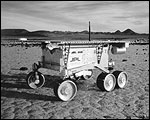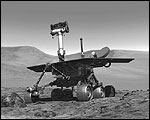| Rover |
|
Sojourner |
|
Rocky
7 |
|
Mars
Exploration Rover (MER)
|
| |
|
 |
|
 |
|
 |
 |
| Mass |
|
11.5 kg
|
|
15.7kg
|
|
185kg |
 |
| Size |
|
60cm x 40cm
x 35cm
|
|
60cm x 40cm
x 33cm |
|
Height 157cm |
 |
| Speed |
|
0.007 m/sec
(0.4 m/min)
|
|
|
|
0.05 m/sec
(3m/min) |
 |
| One-Day
Range |
|
5m
(Must stay within sight of the Lander)
|
|
|
|
100m (Does not depend on the Lander)
|
 |
| Total
Range |
|
Designed
for 20m (Lasted 100m) |
|
|
|
Designed
for 1000m (Mission success defined at 600m) |
 |
| Expected
Lifetime |
|
7 Days (Lasted
83) |
|
|
|
90 Days (Could
last longer) |
 |
| Mission
Description |
|
During July
1997, explore the terrain of Mars within sight of the Pathfinder lander,
conducting technology and science experiments. |
|
On Earth,
demonstrate new technology concepts for use in a long range (50km)
traversal across Mars. |
|
Scientific goals are to search for, and characterize a wide range
of rocks and soils that hold clues to past water activity on Mars.
Sites targeted appear to have been affected by liquid water in the
past.
|
 |
| Mechanical
System |
|
Mobility
configuration and general size are drawn from the Rocky 4 prototype. |
|
Employs Sojourner
flight spare wheels and steering struts, and is approximately the
same size. All other mechanical designs are new. |
|
The design of the suspension system is similar to the Sojourner
rover "rocker-bogie" system. However wheels and chassis
design are new
|
 |
| Thermal
System |
|
Employs aerogel insulator to stay above -40° C during Mars
night.
Night temperatures on Mars can drop to -96°C (-140°F).
|
|
Designed
with fans to stay below 70°C during terrestrial desert testing. |
|
Rover's WEB operating range (-40° to +40° C). This is achived
through the insulated walls of the rover body being gold-painted.
Aerogel insulator used inside the WEB and limited use of Heaters.
|
 |
| Mobility
System |
|
Six wheel rocker-bogey
with four corner steering. Total of ten actuators.
Motor Control via Bang-Bang on/off motor actuation. based on motor's
output shaft position. monitored by optical encoders. No variable
rate motion is possible.
|
|
Modified six wheel rocker-bogey,
with two tandem wheel pairs on one end and two steering wheels
on other end. Total of eight actuators. Mechanical coupling
of tandem wheels can reduce total actuators to six.
Accurate variable rate motion is accomplished with Proportional
/ Integral / Derivative (PID) motor servoing, Pulse Width Modulation
(PWM) of motor currents, and optical encoder monitoring of output
shaft position.
|
|
Six wheels, each with its own individual motor. The design of the
suspension system is similar to the Sojourner rover rocker-bogie
system.
Motor control is the same as used by Rocky 7
|
 |
| Control
System |
|
Custom surface mount board set using radiation hardened components
with 80C85 CPU, 100 KIPS
|
|
Employs duplicates of Sojourner flight accelerometers and quartz
rate sensor. All computer components are commercial off the shelf
(COTS). CPU is a Commercial 3U VME, 68060 CPU, 100 MIPS. Some other
electronics are custom design, using COTS parts.
|
|
All computer components are commercial off the shelf (COTS). Some
other electronics are custom design, using COTS parts.
On-board memory and processing capacity is roughly roughly 1000
more than Sojourner.
|
 |
| Navigation
System |
|
Black and white CCD cameras, and five laser stripe projectors on
front side of vehicle. Quartz rate gyro. Accelerometers (3). Wheel
optical encoders. Bump detector switches.
Modified Behavior control navigation algorithm developed for Rocky
4. All other rover and ground station software is new.
Software written in C and assembly in a Unix development environment
using a Silicon Graphics
Inventor® based operator interface.
|
|
Black and white CCD stereo camera pairs, three pairs total: front,
back, and mast. Sun position sensor. Quartz rate gyro. Accelerometers
(3). Wheel optical encoders.
Currently uses a version of the Sojourner navigation algorithm,
modified to accommodate the different sensors and steering performance
of Rocky 7. All other on and off-board software is newly developed.
Rocky 7 uses a Wind River® real-time operating system. Real
Time Innovations
ControlShell®, Network Data Delivery System® and on-board
stereo correlation software.
Written in C++, C, Lisp software on a Unix development. HTML/Java®
based Rover operator interface.
|
|
Four B&W Hazcams (Hazard Avoidance Cameras): Mounted on the
lower portion of the front and rear of the rover,
Two B&W Navcams (Navigation Cameras):
Mounted on the mast ,these black-and-white cameras use visible light
to gather panoramic, three-dimensional (3D) imagery.
Two colour Pancams (Panoramic Cameras):
Stereo pair of cameras mounted on the Rover mast and delivers three-dimensional
panoramas of the Martian surface.
One Microscopic Imager:
This monochromatic science camera is mounted on the robotic arm
to take extreme close-up pictures of rocks and soil.
|
 |
| Power
System |
|
GaAs solar panel. One primary, non-rechargeable
battery.
Rover usage about 16W peak.
|
|
Rechargeable NiCad batteries, Six solar panels.
Rover usage about 35W average.
|
|
Rechargeable NiCad batteries, Solar array.
Rover usage about 100W average.
|
 |
| Scientific
Payload |
|
Alpha
Particle X-Ray Spectrometer (APXS)
Irradiates rocks and soil and determines their chemical components
from the backscatter signature. |
|
COTS
Visible/Near-IR Reflectance Spectrometer
Pointed and calibrated by rover arm; sensitive from 350-850 nm.
COTS Color Filter Stereo
Iimager
Mast mounted CCD cameras with RGB filters.
COTS
Multispectral Close-up Imager
Close focus CCD camera with multi-spectral
LED illumination.
Mossbauer
Spectrometer
Flight qualified science instrument
for measuring iron content in soils and rocks. Sometimes attached
to rover in place of close-up imager.
|
|
Panoramic
Camera
Microscopic Imager (MI)
Miniature
Thermal Emission Spectrometer (Mini-TES)
Mossbauer
Spectrometer (MB)
Alpha
Particle X-Ray Spectrometer (APXS)
Rock
Abrasion Tool (RAT)
Magnet
Array
|
 |
| Manipulation
System |
|
A one DOF
arm mechanism for deploying the one science instrument. (APXS) |
|
The shorter four degrees-of-freedom (DOF) arm stows against the
side the chassis and can dig, dump, grasp rocks, carry one sample,
and point an integrated optical spectrometer and its calibration
target.
The longer three DOF mast stows in a slot in the solar panel, can
raise a stereo camera pair and filter wheels to 1.4 meters above
the ground, use these same cameras to visually inspect the entire
vehicle, and deploy another 0.5 kg instrument canister to targets
in a large area around the rover.
|
|
The robotic arm has flexibility through three joints (3 DOF). At
the end of the arm is a turret, shaped like a cross. This turret,
a hand-like structure, holds various tools that can spin through
a 350-degree turning range. The four tools, or science instruments,
on the robotic arm are:
The
Microscopic Imager
The Mossbauer Spectrometer
The
Alpha Particle X-Ray Spectrometer
The
Rock Abrasion Tool
The Pancam Mast Assembly stands 1.4 meters from the base of the
rover wheel. The pancam mast assembly serves two purposes:
To act as a periscope for the Mini-TES
science instrument, and to provide height and a better point
of view for the Pancams
and the NavCams.
|
 |
| |
|
|
|
|
|
|





